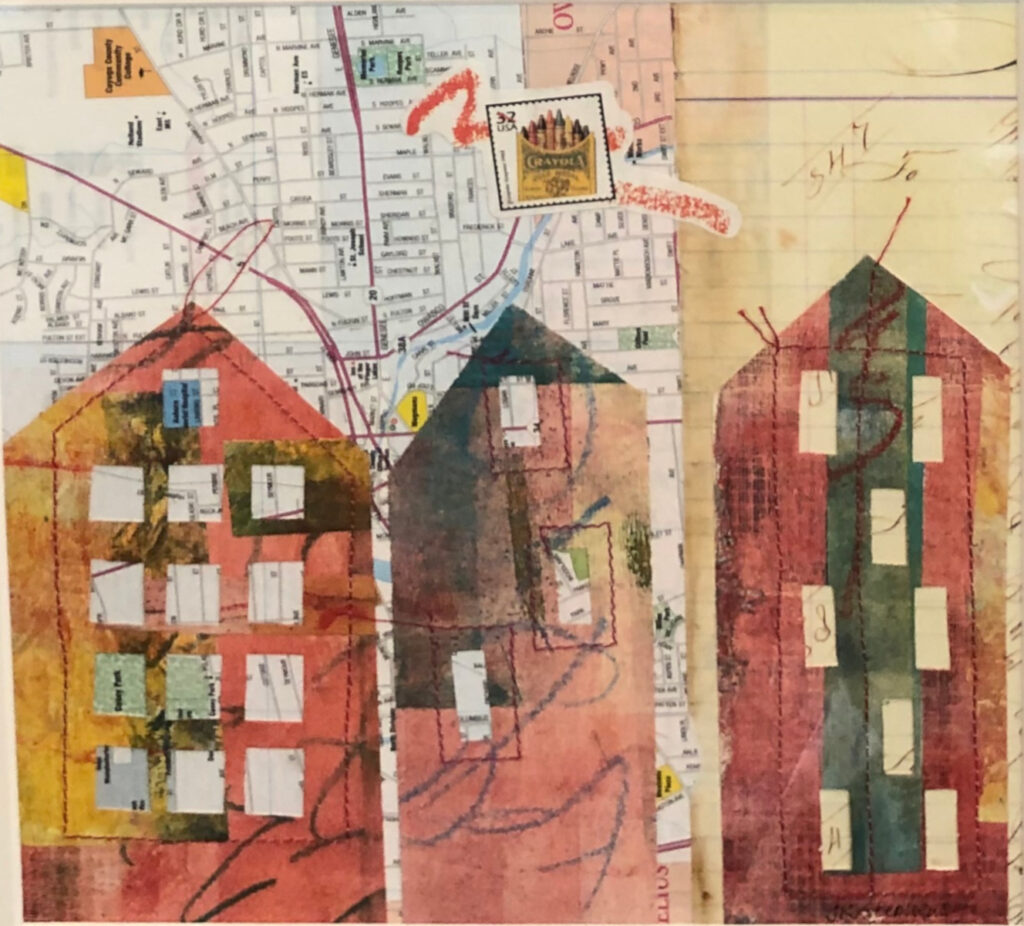Visual poems from the pandemic

On The Map, Jean Stephens, mixed media collage
The pandemic had some upsides. My son and his family moved from California to live a mile away from us here in Pittsford, N.Y., after they discovered they could keep working in movies and television from thousands of miles away. It’s suddenly the Zoom era, and we couldn’t be happier about it. Jean Stephens, already living here in Western New York, took advantage of her self-imposed isolation to liberate her imagination through the act of simply paying attention to what she was enduring: both her physical confinement and how it launched her imagination into a series of soaring and lyrical new collages.
It’s a major shift in the way she makes art.
She does gelli monoprints and then uses the patterns created on the paper she applies to the acrylic-impregnated gel to carve out the shapes of houses and buildings. These are applied to a substrate of colored patterns Stephens pulls from her medium when applied to textured surfaces—the textures she has discovered in objects from a variety of sources, including a hardware store. Into the mix, she works the curving lines of script from old letters or other printed material. She collects objects wherever she finds them in her travels—stamps, letters, cards, as well as anything that has an interesting surface from which she can pull a pattern, including something as mundane as drywall tape. She uses all of them, picking just the ones that seem to work in juxtaposition with one another to create a little visual song of memory, imagination and yearning. Each image is like a visual poem, and in one, an Irish postage stamp floats in the sky above a house perfectly evoking the thwarted longing for freedom everyone felt last year. Her luminous color harmonies are marvelous.
Her work is on view at the Stephen Merritt Gallery, Merritt’s stand-alone studio situated behind his home on a densely wooded hillside north of Rochester. He converts his studio into a gallery for occasional shows. This one features, in addition to Stephens, fascinating new drawings from her husband Bill Stephens, Loraine Cooley’s beautiful jewelry and Dick Westfall’s amazing woodwork.
Stephen Merritt learned how to create his assiduously crafted terra cotta vessels in the late 1960s and early 1970s, studying in Japan under the guidance of Ishikawa Seiho and Inoue Manji. He has been deepening his understanding of the techniques he acquired over the past five decades. While the vessel is still moist, he brushes it with a variety of clay slips—watery solutions of different kinds of clay. His surfaces have a lustrous semi-gloss, or even matte, finish that suggests layers of subdued color, in the way living tissue reflects from various depths to create complex flesh tones. Each vessel seems to vibrate differently to the eye, but all of them emanate a balanced, meditative tone, a kind of spiritual energy that’s contained, withheld, but alive. His work is in the permanent collections of the Smithsonian American Art Museum, the Museum of Fine Arts, The Burchfield-Penny Museum, the Memorial Art Gallery and the Everson Museum.
Comments are currently closed.